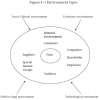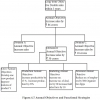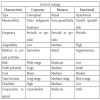Strategic Management - Environmental Analysis and Diagnosis
Macro Environment Analyzed - Environmental Analysis
Posted On :
Now, we will examine the various factors in the macro environment and identify the type of impact they make on business organizations.
Macro Environment Analyzed
Now, we will examine the various factors in the macro environment and identify the type of impact they make on business organizations.
The socio cultural environment is one of the key elements of macro environment. Figure 4-3 lists the key variables in this environment. Demographics like literacy rates, sex ratios, child birth rates, age distribution, educational levels life style, geographic distribution, mobility of the pollution cultural variables like beliefs, values, faiths, religion, customs and traditions, environment folkways, etc., are part of the social changes in society may be slow or fast but change is inevitable in any business environment. Examples in the Indian business environment include -
1. Growing fast food culture
2. Women moving from kitchens to corporate
3. Burgeoning middle class
4. Increasing literacy levels
5. Declining birth rates and increasing senior citizens
Now, we will examine the various factors in the macro environment and identify the type of impact they make on business organizations.
Socio -Cultural Environment
The socio cultural environment is one of the key elements of macro environment. Figure 4-3 lists the key variables in this environment. Demographics like literacy rates, sex ratios, child birth rates, age distribution, educational levels life style, geographic distribution, mobility of the pollution cultural variables like beliefs, values, faiths, religion, customs and traditions, environment folkways, etc., are part of the social changes in society may be slow or fast but change is inevitable in any business environment. Examples in the Indian business environment include -
1. Growing fast food culture
2. Women moving from kitchens to corporate
3. Burgeoning middle class
4. Increasing literacy levels
5. Declining birth rates and increasing senior citizens
6. Increasing health consciousness
Socio-cultural factors affect buying preferences, usage patterns and life style adaptations. Firms, which ignore the socio cultural environments, tend to loose.
McDonalds, the world’s fastest growing fast food chains extended Indian market with beef and pork as ingredients in its pizzas and burgers. Since Hindus are religiously against cow slaughter and do not consume beef and Muslims hate pork these was great opposition in Bombay and the local shiv sena activities broke down McDonald’s fast food center at Mumbai. Today the company relaunched its products with ‘no beef and no pork’ sign boards and even gave wide publicity that animal fat is not used in its restaurants. Further to Indianise its products new versions for Indians like Mc. Imli (with tamarind), Mc spic (with Indian spices) etc are introduced exclusively for Indian market.
Peculiar usage forms include:
Vicks Vaporub is used as a mosquito repellent in some tropical countries. Hair dyes are used for marking animals and washing machines for making Lassi in some rural areas of Punjab.
Key Social, Cultural and Demographic Variables
1. Childbearing rates
2. Number of specific interest groups
3. Birth and death rates
4. Life expectancy rates
5. Attitude towards work and organization
6. Attitude towards government
7. Attitude towards authority
8. Ethical norms
9. Value system
10. Composition of work force
11. Attitude towards income, savings and capital formation
12. Social ethos towards work and organization
Socio-cultural factors affect buying preferences, usage patterns and life style adaptations. Firms, which ignore the socio cultural environments, tend to loose.
McDonalds, the world’s fastest growing fast food chains extended Indian market with beef and pork as ingredients in its pizzas and burgers. Since Hindus are religiously against cow slaughter and do not consume beef and Muslims hate pork these was great opposition in Bombay and the local shiv sena activities broke down McDonald’s fast food center at Mumbai. Today the company relaunched its products with ‘no beef and no pork’ sign boards and even gave wide publicity that animal fat is not used in its restaurants. Further to Indianise its products new versions for Indians like Mc. Imli (with tamarind), Mc spic (with Indian spices) etc are introduced exclusively for Indian market.
Peculiar usage forms include:
Vicks Vaporub is used as a mosquito repellent in some tropical countries. Hair dyes are used for marking animals and washing machines for making Lassi in some rural areas of Punjab.
Key Social, Cultural and Demographic Variables
1. Childbearing rates
2. Number of specific interest groups
3. Birth and death rates
4. Life expectancy rates
5. Attitude towards work and organization
6. Attitude towards government
7. Attitude towards authority
8. Ethical norms
9. Value system
10. Composition of work force
11. Attitude towards income, savings and capital formation
12. Social ethos towards work and organization
Tags : Strategic Management - Environmental Analysis and Diagnosis
Last 30 days 526 views















